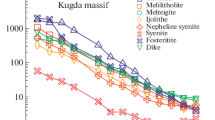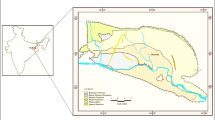Abstract
Cumulus apatite, sphene, feldspar, amphibole and biotite from the pulaskite of the Kangerdlugssuaq alkaline intrusion have been analysed for rare earth elements (REE) by instrumental neutron activation analysis. The apatite is particularly rich in REE, contains 3.6% Ce and shows a steep, light REE-enriched, chondrite-normalised pattern. The other minerals have light REE enrichment but with sphene showing a peak at Ce on a chondrite-normalised plot. REE partition coefficient values show that the light REE are preferentially accommodated by apatite relative to sphene. The differences in these coefficients result from differences in the co-ordination of the REE in the two minerals.
Similar content being viewed by others
References
Calvo, C., Faggiani, R., Krishnamachari, N.: The crystal structure of Sr9.402 Na0.209 (PO4)6B0.996O2 — a deviant apatite. Acta Crystallogr. B31, 188–192 (1975)
Craft, E.F.: Minor elements in igneous and metamorphic apatite. Geochim. Cosmochim. Acta 30, 375–398 (1966)
Cullers, R.L., Medaris, G., Jr.: Rare earth elements in carbonatite and cogenetic alkaline rocks: examples from Seabrook Lake and Callander Bay, Ontario. Contrib. Mineral. Petrol. 65, 143–153 (1977)
Deer, W.A., Howie, R.A., Zussman, J.: Rock Forming Minerals. Vol. 1. Ortho- and ring silicates; Vol. 5 Non-silicates. London: Longman 1962
Dodge, F.C.W., Mays, R.E.: Rare earth element fractionation in accessory minerals, central Sierra Nevada batholith. U.S. Geol. Survey Prof. Paper 800-D D 165 (1972)
Eby, G.N.: Abundance and distribution of the rare-earth elements and yttrium in the rocks and minerals of the Oka carbonatite complex, Quebec. Geochim. Cosmochim. Acta 39, 597–620 (1975)
Evensen, N.M., Hamilton, P.J., O'Nions, R.K.: Rare-earth abundances in chondritic meteorites. Geochim. Cosmochim. Acta 42, 1199–1212 (1978)
Flanagan, F.J.: 1972 values for international geochemical reference samples. Geochim. Cosmochim. Acta 37, 1189–1200 (1973)
Hellman, P.L., Green, T.H.: The role of sphene as an accessory phase in the high-pressure partial melting of hydrous mafic compositions. Earth Planet. Sci. Lett. 42, 191–201 (1979)
Kay, M.I., Young, R.A.: Crystal structure of hydroxyapatite. Nature (London) 204, 1050–1052 (1964)
Kempe, D.R.C., Deer, W.A., Wager, L.R.: Geological investigations in east Greenland. Part VIII. The petrology of the Kangerdlugssuaq alkaline intrusion, east Greenland. Medd. Groenland 190 (2), 1–19 (1970)
Kempe, D.R.C., Deer, W.A.: The petrogenesis of the Kangerdlugssuaq alkaline intrusion, east Greenland. Lithos 9, 111–123 (1976)
Mongiorigi, R., Sanserino, L.R.: A reconsideration of the structure of titanite CaTiOSiO4. Miner. Petrogr. Acta 14, 123–141 (1968)
Murata, K.J., Rose, H.H., Carron, M.K., Glass, J.J.: Systematic variation of rare-earth elements in cerium-earth-minerals. Geochim. Cosmochim. Acta 11, 141–161 (1957)
Nagasawa, H.: Rare earth concentrations in zircons and apatites and their host dacites and granites. Earth Planet. Sci. Lett. 9, 357–364 (1970)
Posner, A.S., Perloff, A., Dioro, A.F.: Refinement of the hydroxyapatite structure. Acta Crystallogr. 11, 308–309 (1958)
Rass, I.T.: Some rare elements in sphene and apatite of the Koksharov ultramaflc-alkalic massif (Primor'ye). Geochem. Int. 2, 213–221 (1964)
Shannon, R.D., Prewitt, C.T.: Effective ionic radii on oxides and fluorides. Acty Crystallogr B25, 925–946 (1969)
Shannon, R.D., Prewitt, C.T.: Revised values of effective ionic radii. Acta Crystallogr. B26, 1046–1048 (1970)
Sudarsanan, K., Young, R.A.: Significant precision in crystal structural details: Holly Springs hydroxyapatite. Acta Crystallogr. B25, 1534–1543 (1969)
Wass, S.Y.: Fractional crystallisation in the mantle of late-stage kimberlitic liquids — evidence in xenoliths from the Kiama area, N.S.W., Australia. In: The Mantle Samples: Inclusions in Kimberlites and other Volcanics (F.R. Boyd and H. Meyer, eds.). pp. 366–373. Washington: A.G.U. 1979
Author information
Authors and Affiliations
Rights and permissions
About this article
Cite this article
Henderson, P. Rare earth element partition between sphene, apatite and other coexisting minerals of the Kangerdlugssuaq intrusion, E. Greenland. Contrib. Mineral. Petrol. 72, 81–85 (1980). https://doi.org/10.1007/BF00375570
Received:
Accepted:
Issue Date:
DOI: https://doi.org/10.1007/BF00375570




